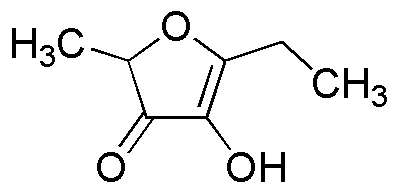5-Ethyl-4-hydroxy-2-methyl-3(2H)-furanone is widely utilized in research focused on:
- Flavoring and Fragrance Industry: This compound is commonly used as a flavoring agent in food products and beverages, providing a sweet, fruity aroma that enhances the sensory experience.
- Cosmetics and Personal Care: It serves as a fragrance component in various cosmetic products, contributing to pleasant scents in lotions, shampoos, and perfumes.
- Pharmaceuticals: The compound is explored for its potential therapeutic properties, particularly in formulations aimed at improving taste in pediatric medicines, making them more palatable for children.
- Aromatherapy: It is utilized in essential oil blends, where its aromatic qualities can promote relaxation and well-being, appealing to both consumers and therapists.
- Research and Development: Scientists investigate its properties for potential applications in developing new flavor compounds or enhancing existing formulations, providing innovative solutions in the food and fragrance sectors.
General Information
Properties
Safety and Regulations
Applications
5-Ethyl-4-hydroxy-2-methyl-3(2H)-furanone is widely utilized in research focused on:
- Flavoring and Fragrance Industry: This compound is commonly used as a flavoring agent in food products and beverages, providing a sweet, fruity aroma that enhances the sensory experience.
- Cosmetics and Personal Care: It serves as a fragrance component in various cosmetic products, contributing to pleasant scents in lotions, shampoos, and perfumes.
- Pharmaceuticals: The compound is explored for its potential therapeutic properties, particularly in formulations aimed at improving taste in pediatric medicines, making them more palatable for children.
- Aromatherapy: It is utilized in essential oil blends, where its aromatic qualities can promote relaxation and well-being, appealing to both consumers and therapists.
- Research and Development: Scientists investigate its properties for potential applications in developing new flavor compounds or enhancing existing formulations, providing innovative solutions in the food and fragrance sectors.
Documents
Safety Data Sheets (SDS)
The SDS provides comprehensive safety information on handling, storage, and disposal of the product.
Product Specification (PS)
The PS provides a comprehensive breakdown of the product’s properties, including chemical composition, physical state, purity, and storage requirements. It also details acceptable quality ranges and the product's intended applications.
Certificates of Analysis (COA)
Search for Certificates of Analysis (COA) by entering the products Lot Number. Lot and Batch Numbers can be found on a product’s label following the words ‘Lot’ or ‘Batch’.
*Catalog Number
*Lot Number
Certificates Of Origin (COO)
This COO confirms the country where the product was manufactured, and also details the materials and components used in it and whether it is derived from natural, synthetic, or other specific sources. This certificate may be required for customs, trade, and regulatory compliance.
*Catalog Number
*Lot Number
Safety Data Sheets (SDS)
The SDS provides comprehensive safety information on handling, storage, and disposal of the product.
DownloadProduct Specification (PS)
The PS provides a comprehensive breakdown of the product’s properties, including chemical composition, physical state, purity, and storage requirements. It also details acceptable quality ranges and the product's intended applications.
DownloadCertificates of Analysis (COA)
Search for Certificates of Analysis (COA) by entering the products Lot Number. Lot and Batch Numbers can be found on a product’s label following the words ‘Lot’ or ‘Batch’.
*Catalog Number
*Lot Number
Certificates Of Origin (COO)
This COO confirms the country where the product was manufactured, and also details the materials and components used in it and whether it is derived from natural, synthetic, or other specific sources. This certificate may be required for customs, trade, and regulatory compliance.


